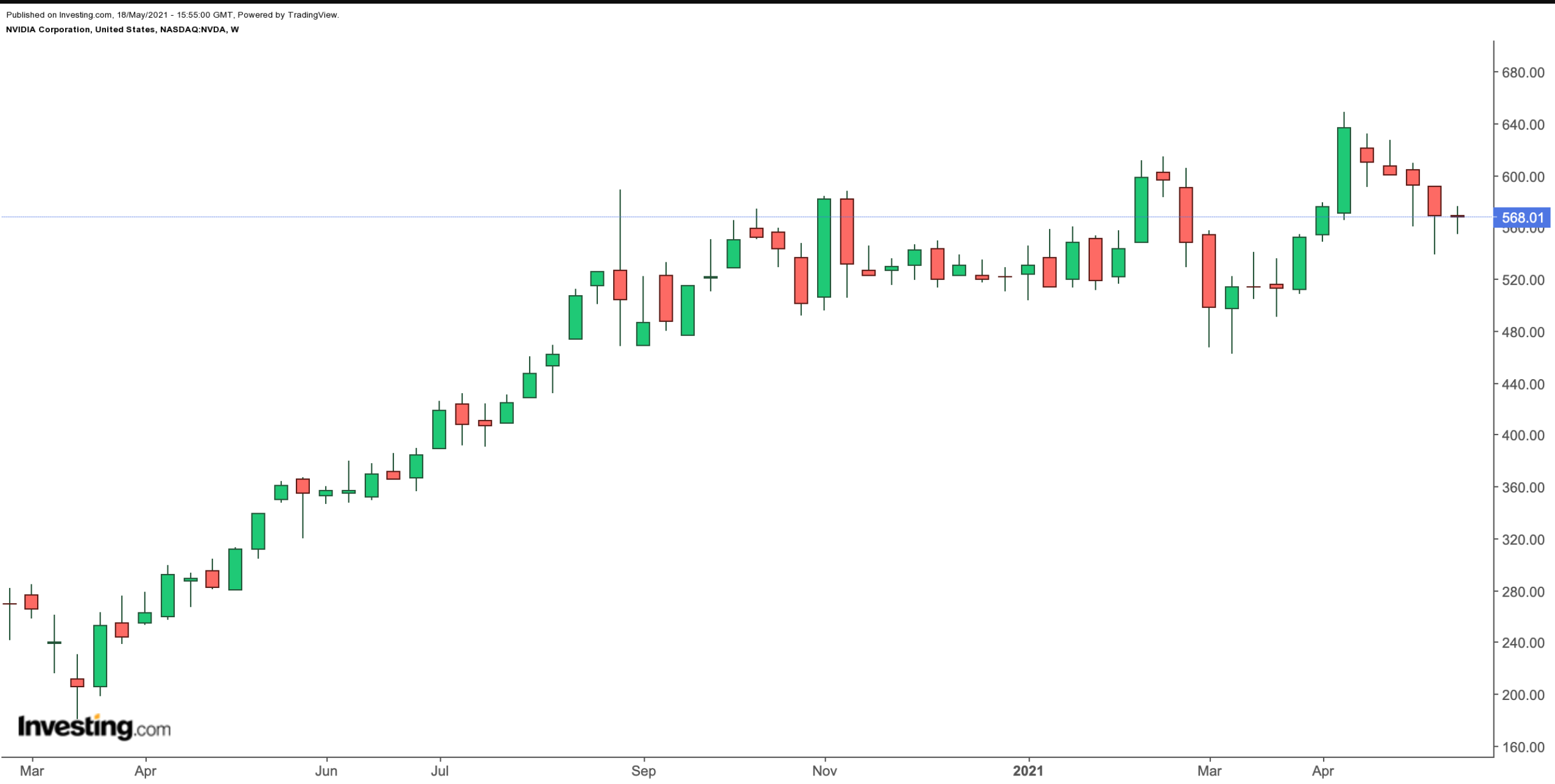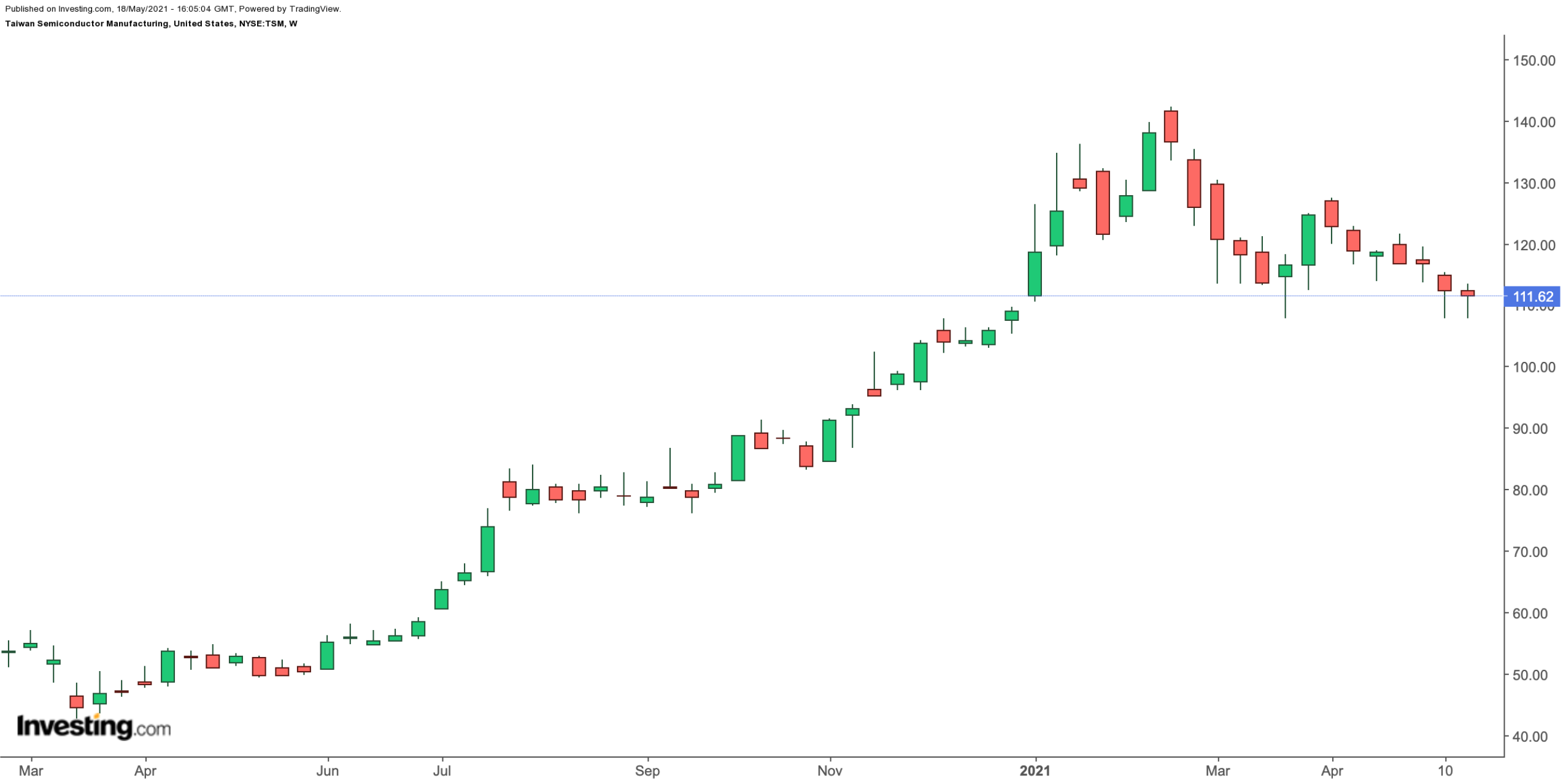Semiconductor stocks have been volatile in recent weeks, in part due to ongoing uncertainties regarding the global chip shortage.
Since early April, most chip shares have come under pressure. In early March, Micron Technology (NASDAQ:MU) was $88.35. Now, it is $79.77. Similarly, on Mar. 30, Advanced Micro Devices (NASDAQ:AMD) was $75.38. Since then it's been range trading around $75.31.
We discussed covered calls to protect recent gains and to decrease portfolio volatility for holders of AMD and MU.
Today, we discuss NVIDIA (NASDAQ:NVDA) and Taiwan Semiconductor Manufacturing (NYSE:TSM) to see how potential investors could set up a covered call trade to potentially take advantage of a sideways to slightly up move in either stock.
As regular readers would know, a covered call position requires owning 100 shares of a given company. However, buying 100 shares of NVDA and TSM would cost around $56,800 and $11,600, respectively—a considerable investment for many people.
In such a case, some investors prefer to put together a "poor person's covered call," on the stock instead. Thus, we introduce a diagonal debit spread on NVIDIA as well as Taiwan Semiconductor Manufacturing.
We will be using LEAPS options, "Long-Term Equity Anticipation Securities.” Readers might also see websites referring to them as LEAP options or LEAPs. Such a position is sometimes used to replicate a covered call position at a considerably lower cost.
Investors who are new to options might want to revisit a similar article we published on Apple (NASDAQ:AAPL) before reading this post. For many readers, today’s piece should help increase their understanding of options. For more experienced investors, we aim to offer ideas for future trades.
A Diagonal Debit Spread On NVIDIA Stock
Current Price: $568.49
52-Week Range: $319.87 - $648.57
Year-to-date (YTD) Price Change: Up 8.8%
Dividend Yield: 0.11%

In this LEAPS covered call strategy, a trader first buys a “longer-term” call with a lower strike price. At the same time, the trader sells a “shorter-term” call with a higher strike price, creating a long diagonal spread.
In other words, the call options for the underlying stock (i.e., NVIDIA in this case) have different strikes and different expiration dates. The trader goes long one option and shorts the other one to make a diagonal spread.
Both the profit potential and risk are limited. The trader establishes the position for a net debit (or cost). The net debit represents the maximum loss.
Most traders entering such a strategy would be mildly bullish on the underlying security—here, NVDA.
Instead of buying 100 shares of NVIDIA, the trader would buy a deep-in-the-money LEAPS call option where that LEAPS call acts as a “surrogate” for owning the NVDA stock.
Mid-day Tuesday, as we write, NVIDIA was trading at $568.49.
For the first leg of this strategy, the trader might buy a deep in-the-money (ITM) LEAPS call, such as the NVDA Jan. 20, 2023, 430-strike call option. This option is currently offered at $185.88 (mid-point of the current bid and the ask spread). In other words, it would cost the trader $18,588 instead of $56,849 to own this call option that expires in over one and a half years.
The delta of this option is about 0.80. Delta shows the amount an option’s price is expected to move based on a $1 change in the underlying security.
In this example, if NVDA stock goes up $1, to $569.49, the current option price of $185.88 would be expected to increase by approximately 80 cents, based on a delta of 0.80. However, the actual change might be slightly more or less depending on several other factors that are beyond the scope of this article.
So an option’s delta increases as one goes deeper into the money. Traders would use deep ITM LEAPS strikes because as delta approaches 1, a LEAPS option's price moves begin to mirror that of the underlying stock. In simple terms, a delta of 0.80 would be like owning 80 shares of NVIDIA in this example (as opposed to 100 in a regular covered call).
For the second leg of this strategy, the trader sells an out-of-the-money (OTM) short-term call, such as the NVDA July 16, 2021, 580-strike call option. This option’s current premium is $29.65. In other words, the option seller would receive $2,965, excluding trading commissions.
There are two expiration dates in the strategy, making it quite difficult to give an exact formula for a break-even point in this trade.
Different brokers or online websites might offer “Profit & Loss Calculators” for such a trade setup. Calculating the value of the back-month option (i.e. LEAPS call) when the front-month (i.e., the shorter-dated) call option expires requires a pricing model to get a “guesstimate” for a break-even point.
Maximum Profit Potential
The maximum potential is realized if the stock price is equal to the strike price of the short call on the expiration date of the short call.
In other words, the trader wants the NVIDIA stock price to remain as close to the strike price of the short option (i.e., $580 here) as possible at expiration (on July 16, 2021), without going above it.
In our example, the maximum return, in theory, would be about $3,653 at a price of $580.00 at expiry, excluding trading commissions and costs. (We arrived at this value using an online profit and loss calculator.)
Without the use of such a calculator, we could also arrive at an approximate dollar value. Let’s take a look:
The option seller (i.e., the trader) received $2,965 for the sold option.
Meanwhile, the underlying NVDA stock increased from $568.49 to $580. This is a difference of $11.51 for 1 share of NVIDIA or $1,151 for 100 shares.
Because the delta of the long LEAPS option is taken as 0.8, the value of the long option will, in theory, increase by $1,151 X 0.8 = $920.8 (However, in practice, it might be more or less than this value).
The total of $2,965 and $920.8 equals $3,885.8. Although it is not the same as $3,653, we can regard it as a good approximate value. The main reason behind the difference is that the delta of the LEAPS option was not exactly 0.8.
Understandably, if the strike price of our long option had been different (i.e., not 430), its delta would have been different, too. Then we would need to use that delta value to arrive at the approximate final profit or loss value.
Therefore, by not investing $56,849 initially in 100 shares of NVIDIA, the trader’s potential return is leveraged.
Put another way, the premium the trader initially receives for selling the shorter-dated call option (i.e., $2,965) represents a higher percentage of the initial investment of $18,588 than if the trader bought 100 shares of NVIDIA outright at $56,849.
Ideally, the trader hopes the short call will expire out-of-the money (worthless). Then, the trader can sell one call after the other, until the long LEAPS call expires in about a year and half.
Position Management
Active position management in a diagonal debit spread is typically more difficult for novice traders.
If NVIDIA is above $580 on July 16, the position will make less than the potential maximum return as the short-dated option will start losing money.
Then, the trader might feel the need to close the trade early if the NVDA price shoots up and the short call gets caught deep ITM. In that case, the trader might need to close the entire trade and start over, or put together alternative option strategies.
In a regular covered call, the trader might not necessarily mind being assigned the short option as s/he owns 100 shares of NVIDIA as well. However, in a poor person’s covered call, the trader would not necessarily want to be assigned the short call as s/he does not actually own those NVDA shares, yet.
On July 16, this LEAPS covered call trade would, in theory, also start losing money if the NVIDIA stock price falls to about $538 or below. However, the actual break-even point could be different, as there are different variables that affect the price of an option. Understandably, a stock's price could drop to $0, decreasing the value of the long call with it.
Finally, we must also remind readers that deep ITM LEAPS options tend to have high bid/ask spreads. Therefore, every time the trader buys or sells such a LEAPS option, there could be a significant transaction cost.
Now, let’s also look at TSM stock.
A Diagonal Debit Spread On TSM Stock
Current Price: $111.63
52-Week Range: $49.61 - $142.19
YTD Price Change: Up 1.59%
Dividend Yield: 2.62%

For the first leg of this strategy, the trader might buy a deep in-the-money (ITM) LEAPS call, such as the TSM Jan. 20, 2023, 90-strike call option. This option is currently offered at $29.55. So it would cost the trader $2,955 instead of $11,163 to own this call option that expires in over one and a half years.
Like the example of NVDA stock, the delta of this option is also about 0.80.
For the second leg of this strategy, the trader sells an out-of-the-money (OTM) short-term call, such as the TSM July 16, 2021, 115-strike call option with a premium of $4.10. So the option seller would receive $410, excluding trading commissions.
Maximum Profit Potential
As we have seen above, the maximum potential is realized if the stock price is equal to the strike price of the short call on the expiration date of the short call.
In other words, the trader wants the TSM stock price to remain as close to the strike price of the short option (i.e., $115 here) as possible at expiration (on July 16, 2021), without going above it.
In our example, the maximum return, in theory, would be about $634 at a price of $115 at expiry. (Again, we arrived at this value using a profit and loss calculator online.)
Without the use of such a calculator, we could also arrive at an approximate dollar value. Let’s take a look:
The option seller (i.e., the trader) received $410 for the sold option.
Meanwhile, the underlying TSM stock increased from $111.63 to $115. This is a difference of $3.37 for 1 share of TSM or $337 for 100 shares.
Because the delta of the long LEAPS option is taken as 0.8, the value of the long option will in theory increase by $337 X 0.8 = $269.6 (However, in practice, it might be more or less than this value).
The total of $410 and $269.6 comes to $679.6. Although it is not the same as $634, we can regard it as a good approximate value.
Therefore, by not investing $11,163 initially in 100 shares of TSM, the trader’s potential return is leveraged.
The trader wants the short call to expire out-of-the money (worthless). Then, the trader can sell one call after the other, until the long LEAPS call expires in about a year and half.
Finally, if TSM is above $115 on July 16, the position will make less than the potential maximum return as the short-dated option will start losing money. Then, the trader would need to take appropriate action based on her or his objectives.
